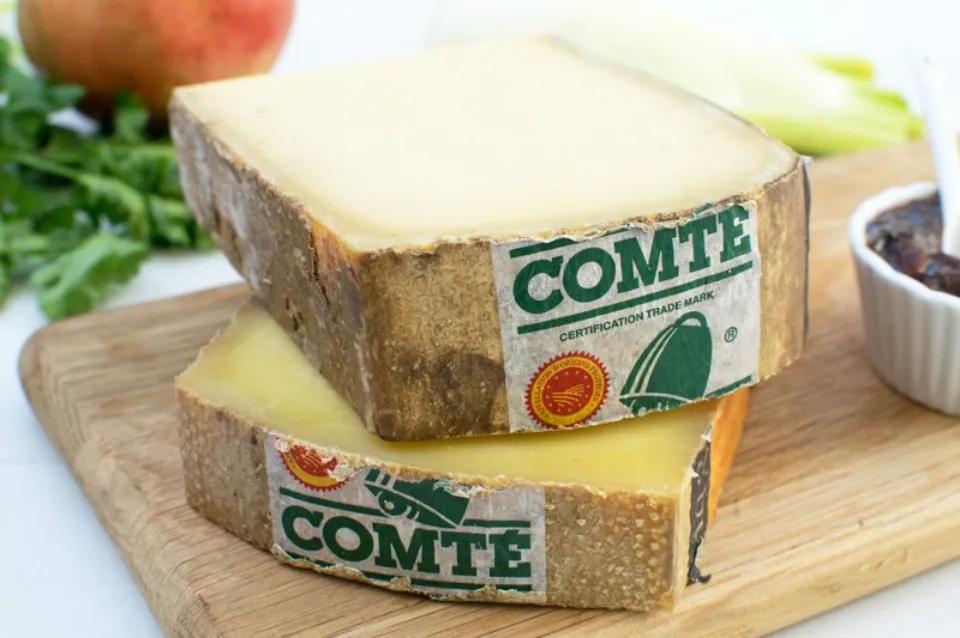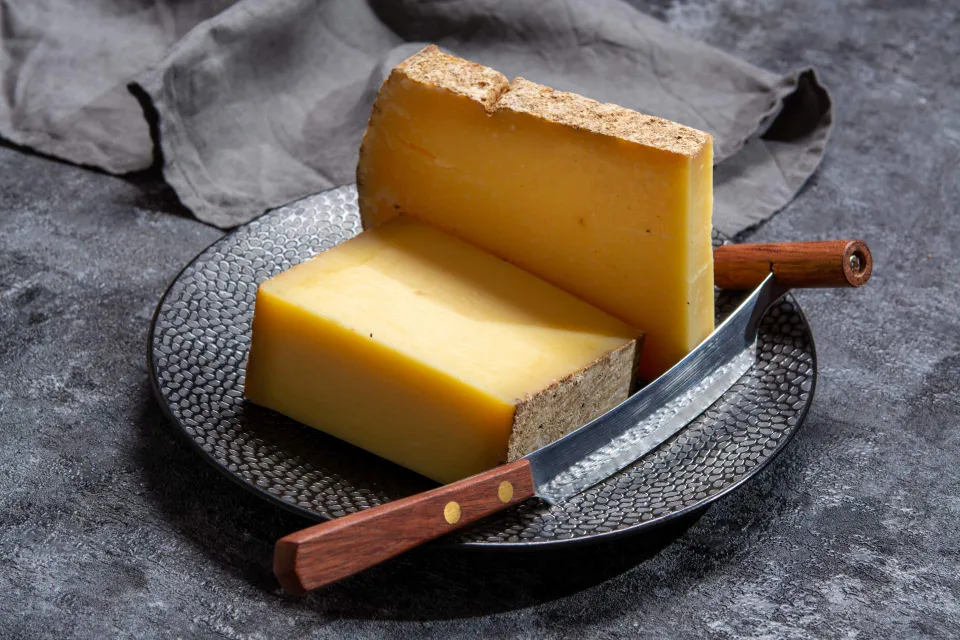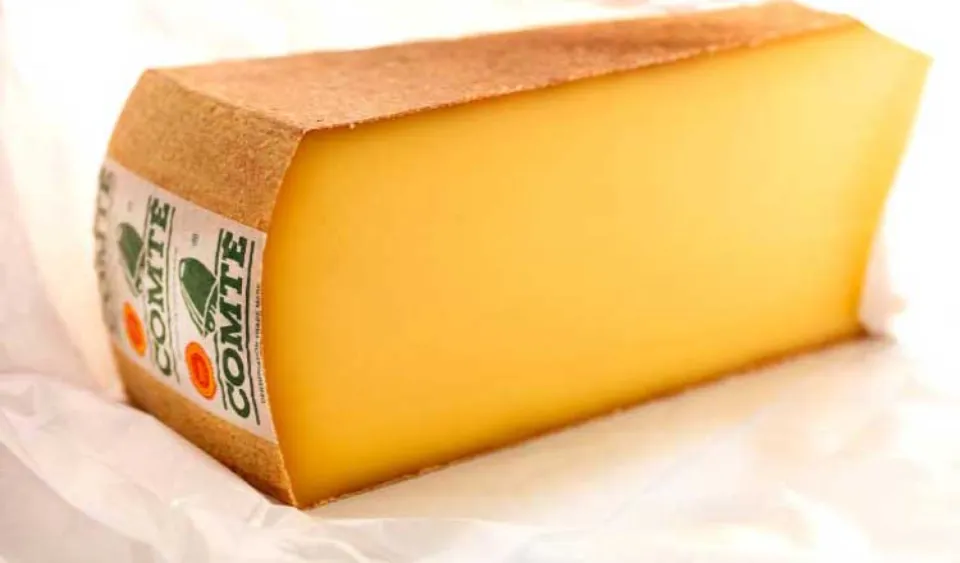If you’ve visited France, you might be not unfamiliar with Comté cheese, it is one of the most popular cheeses among French people.
Comté is a French cow’s milk cheese made from unpasteurized milk. It is also known as “mountain cheese” because it origins in the mountains near the border with Switzerland.
Here is more information about Comté cheese.
What is Comté Cheese?
The Jura Massif in eastern France is where Comte cheese is produced using raw cow’s milk. It is a semi-hard cheese with a pale yellow color and a texture that varies from open, supple, and grainy for younger cheeses to dense, firm, and crystalline for more aged cheeses. While younger cheeses have a more milky and fresh flavor, aged cheese has a nutty, smoky, fruity, and sweet flavor.

How Comté is Made
The raising and feeding of the cows, the actual cheesemaking, and the aging of the cheese are all three parts of the process of making Comté cheese. Since Comté cheese has Protected Designation of Origin (PDO) status, every step in the production process is subject to stringent regulations that specify everything from the breed of cow from which the milk is obtained to the utmost distance that can be traveled between pasture and dairy.
Montbéliardes and French Simmental cows, which are raised in the Jura Massif region, provide the milk used to make Comté. The pastureland in this region is renowned for the variety of grasses and wildflowers that grow on it, and each cow is required by law to have at least 2.5 acres (1 hectare) of pasture to graze on. The Montbéliarde cows graze in pastures with at least 400 different species of wildflowers, all of which add to the milk’s richness and depth of flavor and aroma. The hay harvested from these summertime pastures is fed to the cows in the winter. As a result, Comt’e made in the winter may have different flavors from Comt’e made in the summer.
The milk is heated to about 90 F to make Comté, and a starter culture is added to start the fermentation. Rennet is added after an hour, and the temperature is raised to 133 F to hasten the curdling process. After that is finished, the curds are placed in molds that are circular to allow the whey, or extra liquid, to drain.
After one day, the fresh cheese is moved to a cellar at the dairy where it stays for three weeks before being moved to a different aging cellar where it will stay for four to twenty-four months while being turned and washed every day with brine to form the rind. The cheese’s color transitions from white to yellow during this time, as well as the flavors and aromas, which become more nutty and spicy. The texture also changes from supple to firm.
Types of Comté Cheese
The two primary variations of Comt are summer Comt and winter Comt. The distinctions are due to the cows’ diets, as they consume hay produced from the same pastureland in the winter and summer respectively. In the summer, cows eat grasses and wildflowers. While the winter variety is milder and milkier, the summer variety has a more earthy flavor and a more golden color.
Uses of Comté Cheese
Younger Comte is a fantastic melting cheese, so Gruyere and Emmenthal are frequently added to create fondue. They also function in mac and cheese, grilled cheese sandwiches, and omelets. The more mature varieties can also be used in mac and cheese when combined with other cheeses. The more mature varieties are harder and don’t melt quite as smoothly, more closely resembling cheddar or Parmesan, so they’re great for grating over vegetables and casseroles. A great cheese for a cheese platter is Comt, which is also a great cheese for snacking.

How to Storage Comté Cheese
Although it is warmer than the temperature inside a refrigerator, Comté should be stored at a temperature of 45 to 55 F. However, your fridge will have to do since it is likely warmer than 55 F on your kitchen counter. The cheese should be wrapped in parchment or wax paper and kept in the refrigerator’s cheese drawer in a covered container. Before serving, let it sit for an hour at room temperature for the best flavor.
Substitutes for Comté
Cheeses that offer qualities of their own produce the best results when trying to find a substitute with an equivalent sense of elegance and ubiquity in taste.
Gruyère and Comté share a lot in common with cave-aged cheese. It exhibits stronger butter and hazelnut tones but otherwise tastes and feels almost identical. You won’t perform any better as Comte’s replacement than the Swiss Gruyere.
Fontina stands in admirably for Comte in the case of a different perspective. With a dense texture that is perfect for melting, it also boasts subtle hints of browned butter and roasted nuts.

Conclusion
French cow’s milk cheese known as Comte is produced using unpasteurized milk. Known as a “mountain cheese,” Comte is one of the best and most well-liked cheeses in France. To replace it, we can use Fontina or Gruyère cheese.
Related Reading
What You Should About Cotija Cheese
All You Want to Know About Pepper Jack Cheese
The Ultimate Guide to Colby Jack
FAQs
What Does Comté Taste Like?
The taste and texture of Comté changes as it ages. A young Comté generally has aromas of fresh butter, dried apricots and soft caramel, whereas a long-matured Comté will be more fruity, spicy and nutty.
Is Comte Cheese Similar to Cheddar Cheese?
Comté is to the French what Cheddar is to the English. A ubiquitous hard sharp cheese that is as at home inside an omelette or grated on top of pasta as it is on a cheeseboard. It’s known for its complex fruity and nutty flavour.
Why Is Comte Cheese so Expensive?
Really it’s down to the production and manufacturing of the cheese and the many procedures and rules that the farmers and producers must abide by in order to call the cheese Comté.


